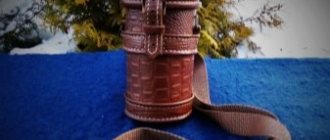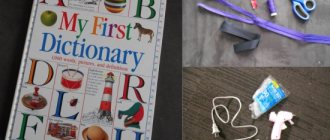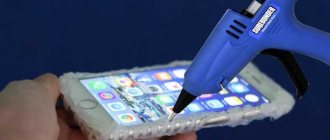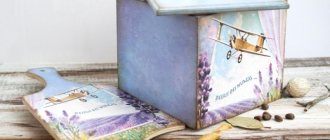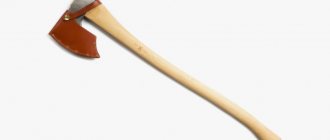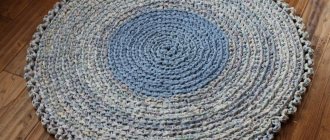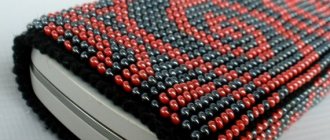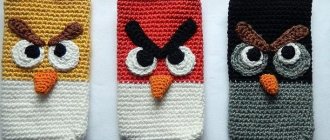Sewing a cover for an ironing board is easy, the main thing is to know how to do it correctly and have a sewing machine. The need to replace the cover may arise if the old cover has worn out, lost its attractive appearance, or was accidentally burned through by a hot iron. During use, the old fabric gradually becomes clogged with dust, and after 10-15 years, when using a dirty board, you may encounter the problem of stains appearing on clean white linen.
Of course, you can purchase a ready-made, new case in the store. But, if you need to replace the fabric on an old-style ironing board that has long been discontinued, it may not fit. In addition, when buying a finished product, you may not be able to guess the dimensions even for a modern board. As a result, the cover will dangle, form wrinkles and complicate the ironing process.
Materials and tools
In order to reupholster the ironing board, we will need the following materials and tools:
- old ironing board;
- two meters of fabric of your choice (it is better to use cotton fabric);
- two pieces of batting;
- sewing machine;
- scissors;
- threads;
- pins;
- needles.
The following materials can be used for padding:
- blanket;
- Quilt blanket;
- batting;
- towel.
I prefer a quilt because I have plenty of that stuff in my house. You can easily use multiple layers to create a padded board.
Whatever fabric and padding you choose, just make sure you can use it all and not in sections. If you need to sew multiple pieces of fabric or padding to form one piece, the seam lines will cause unevenness in the covering. This means you will have to work hard to get even pieces.
Do-it-yourself fabric reupholstery on an ironing board
Do-it-yourself fabric reupholstery on an ironing board
My ironing board is exactly 10 years old.
My mother gave it to me with the hope that her daughter would become a good wife. This daughter was very obstinate and got married at 18 with the words: I won’t cook! I won't iron! and down the list to the phrase - You didn’t marry a housewife!
This daughter was very obstinate and got married at 18 with the words: I won’t cook! I won't iron! and down the list to the phrase - You didn’t marry a housewife!
And how did my husband marry such a person, I still wonder? :))
My mother slowly brought various “useful things” into our house with my husband - frying pans, irons, dishes... - my mother is a wise person and, of course, she understood that at some point my hands would take up all this themselves. And so it happened! The obstinate wife outgrew her obstinacy and became more flexible and “homely” :))
But it's time to return to the ironing board.
Lately it has been scary to look at it - the fabric is streaked with iron scale, frayed on the folds and in some places there are even holes, and all sorts of glue and thermal applications have left their marks. This made ironing on the board not only unpleasant, but also dangerous - stains were imprinted on the fabric I was ironing. I stopped ironing on it and did it on the table, which is very inconvenient, since the table is always occupied and before ironing, I had to clean it, wipe it, cover it...
And what can I say - an ironing board is a necessary thing. And I decided that it was time to end this inconvenient ironing!
You only need to spend an hour and reupholster the ironing board! Here there may be some disputants who will say that it’s easier to sew/buy a cover. I agree, but!
Related article: How to lay porcelain tiles + photos in the interior
1. The “native” fabric of the ironing board is such that you need to get rid of it urgently! Stains from it can transfer to the cover.
2. I wanted to compact the ironing board under the fabric so that its edges became softer (there were no clear lines left from the dimensions of the ironing board, for example, when ironing bed linen)
The whole rework cost me 280!!! rubles and an hour of work.
So we need one and a half meters long and 45 cm wide fabric, for example cotton, as in my case.
1.5 meters of batting (width 80 cm) or any other sealant, such as foam rubber. Batting is cheap and soft - I chose it.
I apologize for the dark photos - I took MK in the evening, under artificial lighting 
and tools: scissors, furniture stapler, chalk, knife with a short blade (not in the photo)
turn the ironing board over
and pull out the old staples around the perimeter
It is better to do this with a knife with a sharp and short blade. And even better, with men's hands. This is the most difficult operation and my husband performed it for me.
under the old rag there was old and very loose foam rubber
We throw away the foam rubber, and transfer the fabric to a new one and trace the outline with chalk
I cut the fabric with an allowance of + 3 cm around the perimeter with the expectation of a thicker seal.
Now fold the batting in half and cut it out
You can see in the photo that the batting has already been cut out - everything is correct - when we staple, we will tuck the fabric, but not the batting.
Now place the ironing board in the center
and starting from the middle, bending the edges of the fabric inwards, insert the staples (my husband did this too - I didn’t have enough strength)
Now, so that the corners do not puff up, we will cut off all the excess batting and fabric (but do not forget that the fabric will need to be tucked)
Related article: DIY bunk bed for children: manufacturing process
carefully fold the fabric and form even corners
Now you can still tighten up the loose screws and touch up the peeling paint.
Turn it over and rejoice 
Hands just reached out to urgently stroke something :))
So happy - minimum financial and time costs, and what a new thing :)))
In the future, it will be possible to sew a cover with an elastic band or simply change the clothes of your ironing board more often.
I hope that this MK will inspire in you the desire to update your “workhorse” and make your handicraft corner even dearer to your heart.
Preparation stage
Remove the lid and set it aside. Place the pad on the floor and the ironing board on top of it. We lay the lining in two layers. Take a marker and trace the edge of the ironing board.
If you decide to make the lining with only one layer of material, simply cut along the line. If you are making multiple layers, staple the layers together and trim them outside the lines. We'll need to stitch it all together later.
Why hysteria is a stage of development, and how to help your child survive it
It’s easy to make a duvet cover of the desired size from two sheets: it turns out comfortable
When to collect birch sap in 2022 and how to choose the right tree
How to Renew an Old Ironing Board Cover
It’s already been a year since I did this master class and my cover became worn out during the work, the drawing faded and its shabby appearance did not fit into my cozy workshop. I decided to update the case, and now I’ll show you how quickly and easily it can be done in 10 minutes. All I needed for this was a piece of fabric (poplin) 45 Washing machine.
I remove the old cover from the ironing board and take out the elastic. I smooth it with an iron until it looks flat. I will use it as a pattern.
I put the cover on the fabric and cut out exactly the same piece based on it, without allowances. I cut off 0.5 Washing machine along the entire perimeter from the edge, so the new pattern seems to be slightly smaller.
I overcast the edges of the pattern using an overlocker, or you can overcast with a zigzag stitch on a sewing machine. The main thing is that they do not crumble.
I place the processed pattern on top of the old cover on the front side. I fasten them together with tailor's pins.
From the wrong side, I use a sewing machine to make a straight stitch, trying to get into the elastic seam (point 6 above).
All you have to do is insert the elastic band and the updated ironing board cover is ready!
You might be interested:
Sew the lining
If you're using multiple layers, it's a good idea to stitch them together so you don't have any offset. We sew directly on the line that we drew with a marker. Having done this, take out the pins and cut just behind the stitch line.
You can now place a pad on the board to use as a temporary ironing board while you work on the restoration.
How to choose and correctly change the cover for your ironing board?
Ironing clothes is a process that we encounter every day in everyday life. And this daily work would be even more labor-intensive without a high-quality ironing board.
The selection of boards is large and varied. The ironing board can be the most ordinary one - the same as our grandmothers and mothers used, or a fashionable, improved one. Modern boards come with a fan, a roller and other “know-how”. They can also be built-in, folding or tabletop.
But there is something that unites them all. Each ironing board needs a cover, which directly affects the quality of ironing. Usually the cover comes with the board, but sooner or later there is a need to change it.
In this article we will talk about the types of covers and draw your attention to the main criteria when choosing the right cover for a board.
Preparing old coating
If your ironing board had a cover, now is the time to rip it open and make a pattern out of it.
Remove the lace or elastic (you may need to trim it) and place the material on the ironing board. We use an iron to smooth out the old cover.
Place the cover on the floor and place the ironing board on top to see how large the seam allowances were. To achieve the best results, it is better to make allowances of 5-7 centimeters.
Alexandra Shoua's eldest daughter grew up without him, but forgave him all his insults
On March 20 they launched a burning wheel: rituals on the day of the spring equinox
In Russia they are asking to cancel the mandatory fee for choosing a seat on an airplane
Types and materials
There are several coverage options in different price categories. To save money, it’s easier to choose a regular and cheap option and change it as it wears out. But you can choose a coating that is more expensive and more functional. Modern, improved cases are considered expensive. Let's look at a few options:
- The cheapest one is a cotton cover .
- A cover made of synthetic fabric will cost a little more It is waterproof, non-flammable and does not allow the iron to stick.
- Coverings with metal threads inside, which allow ironing more efficiently. The iron interacts with the metal, heating the fabric on both sides. This significantly improves the ironing process. An iron left on the ironing board can sit for up to 4 hours without burning.
- Option with a non-stick coating, which is made of cotton fabric impregnated with silicone. This impregnation helps protect clothes from burning and yellow spots. In addition, the effect of double ironing occurs, as it heats up from the iron.
- Teflon coated case. It allows you to iron any types of fabrics without burning or sticking, heating clothes on both sides at the same time.
- Another new type of cover of the highest quality, with fire-resistant properties.
Cotton cover - the most inexpensive and common
New material for restoration of ironing board
Iron the fabric for the new cover and place it face down on the floor. We put an old cover or ironing board on top, as is convenient for you.
You can pin the old cover to the fabric and trim it (add extra seam allowance if necessary - remember you want 5-7cm of excess fabric around the edges of the ironing board that will go into the hem), or lay the ironing board down and circle taking into account the allowances.
I added maybe 5mm around the old fabric cover and cut out the shape I wanted using scissors.
Rules for choosing fabric for a cover
Cotton calico is considered the ideal option for upholstering an ironing board, although other types of fabrics can be used if desired. The main thing is that the material does not stretch. Otherwise, the new case will quickly become deformed.
When choosing fabric, you should also consider the following recommendations:
- The material must be resistant to shedding. When ironing using the steam mode, light-colored items may become dirty from the shedding cover and become unusable. To check whether the material is subject to shedding, you will need to wash it in a basin of warm, clean water. If the water remains clean after washing, then the fabric is suitable for sewing a cover, and vice versa.
- A cover that is too light in color will quickly become dirty and covered with yellow spots from the hot iron. Therefore, it is better to opt for darker colors. If you still like light-colored materials, then you can sew several removable covers and replace them periodically.
- The fabric used to cover the ironing board should not contain additives that will stick to the iron when it heats up. Firstly, you will have to constantly clean the soleplate of the iron so that it glides well on things. And secondly, a dirty sole can easily stain the item you are ironing.
We recommend: Cheap “pineapples” made from pumpkin – I marinate it for the winter according to an old Baltic recipe
Sewing a new cover
We draw a line to make a so-called channel for an elastic band or thread.
We install the ironing board so that the gasket is on top, and install the new cover on top as well. Fold the edges by about 0.5 centimeters and press well with an iron.
The channel doesn't have to be perfect, just do it by eye.
Now fold the edges again by about 0.7 centimeters.
The strawberry harvest will increase many times: we water the bushes in the spring with garlic fertilizer
The man thought he got a mini-pig: it turns out he was wrong (photo of the pet)
Seedlings from old seeds: chamomile tea will “wake everyone up”
This can be a little tricky if you've never done this before because the corners are uneven. Try approaching the corners from different angles if you can't get them right the first time. Just make sure you don't fold the material too much or it will make it difficult for the thread or elastic to pass through the body.
I did this job a little sloppily, but I tried.
Take two pins and place them a few centimeters apart in the center of the back of the lid.
We use an allowance of 0.2 centimeters. Starting from one edge, sew everything in a circle.
When it comes to folds, your sewing machine may catch on them. In this case, stop the machine with the needle pointing down and raise the presser foot. Slide the pleated fabric back under the presser foot and continue sewing.
Move to the other marked edge of the body. Remember to backstitch at the beginning and end.
The easiest way to replace your ironing board cover
It is not necessary to sew a cover for the ironing board.
You can simply re-tighten a board with a wooden tabletop by securing the fabric with furniture clips. But first you need to remove the old cover along with the insulation gasket, since when wet it will quickly contaminate the new cover, especially if it is made of white fabric. If you leave the old gasket, and especially if you do not remove the worn fabric upholstery of the board, then it is advisable to use colored fabric for sewing or reupholstering the cover. Cotton fabric, such as calico, is ideal for the cover, but mixed lightweight fabrics can also be used. The main thing is that they do not fade or spoil light-colored items during ironing. By the way, experienced tailors, when ironing light-colored items, throw a clean white cloth over the board.
Deciding on the coating for the ironing board
Covers for ironing boards are made from cotton and synthetic materials. Cotton is easy to wash and breathable, but if cheap dyes were used to dye it, it may fade. Therefore, it is better to choose ironing boards with light-colored covers without patterns. In addition, cheap cotton covers do not last long.
Polyester is often used in the production of budget ironing boards. Polyester covers often stick to the iron and accumulate static electricity. Their service life is 1–1.5 years.
The best materials for covers are fabrics with metallized thread. They have non-stick properties, reflect steam and heat well, which ensures double-sided ironing of clothes. Often such products are coated with Teflon, which increases their durability and strength.
When purchasing, you should also pay attention to the type of fixation of the case. It can be attached to the tabletop using elastic bands, tapes, Velcro and cords. Covers with elastic bands are considered the most unreliable, because... Over time, elastic bands stretch, and those with cords are the most durable.
It is also important that the case has a soft lining (at least 2 mm thick). It facilitates the ironing process and protects against marks left by the metal mesh of the tabletop on clothes.
The linings for the cover are made from batting, foam rubber and synthetic padding. Batting is not recommended for use on boards made of chipboard and plywood, because... it has high moisture permeability and, therefore, contributes to the deformation of the wooden surface.
Additional accessories for ironing
For greater convenience during ironing, the ironing board cover can be slightly “improved”. For example, sew a pocket like this in which you can store an iron cleaner, a sprayer, threads for basting, a pad with needles, etc. But the most convenient and most importantly necessary additional device for an ironing board can be considered various flat pillows. They are very effective for ironing and ironing seam allowances, removing excess moisture from an ironed product, etc. You can make such a pillow from any thin fabric, including synthetic, and put several layers of batting or foam rubber inside. Those who sew with their own hands often require various lasts for ironing sleeves and other hard-to-reach places. You can replace the cover for such a miniature ironing board using the same methods as the cover for the ironing board.
READ Pros and cons of a steam generator for home
Tailor's dummies Sewing a cover for an ironing board is a very simple task for an experienced seamstress. It is much more difficult to reupholster a dilapidated old-style mannequin cover. To sew such a cover, you must first make precise patterns using the ripped apart parts of the removed mannequin skin.
How to choose an ironing system The tabletop ironing system has a number of additional functions, not only pumping air using a fan. The cover of such an ironing board can heat up to 90 degrees, which improves the ironing and drying process.
How to choose the right iron When purchasing a new iron, you need to focus not only on its price, but also on the power of the Tubular Heater, the quality of the coating of the iron sole
The weight of the iron, the shape of the handle, the volume of the steam chamber, etc. are of no small importance. How to choose a household iron with a steam generator In the ironing system, the iron must be a steam iron or with a steam generator
How to choose a household iron with a steam generator In the ironing system set, the iron must be steam or with a steam generator. The cost of such a system is quite high, so if you decide to sew a cover for your ironing board, use only high-quality fabrics.
We sew a sheet with an elastic band with our own hands The technology for sewing a sheet with an elastic band is somewhat reminiscent of the technology for sewing a cover for an ironing board. Clasps are often used to tighten the corners of such a sheet; they can also be used to tighten the ironing board cover.
Stability and supports
When purchasing, pay attention to the width of the legs and the method of fastening. If the legs of the ironing board are not widely spaced, the stability of the product will be poor. The best option is when the base of the legs is wider than the tabletop.
If the legs are attached to the tabletop and to each other using bolts and rivets, they may become loose over time. Rivets are considered the most unreliable method of fixation.
To prevent the board from slipping and scratching the floor, choose products with silicone or rubber caps on the legs.
When purchasing, pay attention to the shape of the legs. T-shaped structures are considered the most stable.
